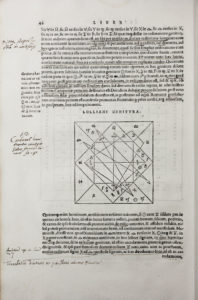![]() Julius Firmicus Maternus, Astronomicon (Basel: Johannes I Herwagen, 1533).
Julius Firmicus Maternus, Astronomicon (Basel: Johannes I Herwagen, 1533).
2 pts. [in 1]: 246 leaves, 31 cm.
London, University College London Library, STRONG ROOM OGDEN A QUARTO 9.
Writing during the Roman Empire’s transition to Christianity, in his Astronomicon Julius Firmicus Maternus aimed to summarize the rudiments and history of astrological study. Though widely overshadowed in the Middle Ages after the introduction of astronomical texts from the Islamic world, its printing by Aldus Manutius in 1499 reintroduced Maternus’s work as a foundational text for the learning of astronomyand the casting of genitura—astrological charts depicting the position of the heavens at the moment of an individual’s birth. This edition, the first produced in Basel by Johann Herwagen (who would later produce the edition of Livy’s Decades annotated by Gabriel Harvey), was edited by the former Augustinian astronomer Nicholas Pruckner (1494-1556), and included two additional ancient astrological works revived by the Latin humanists. The first of these was Ptolemy’s Quadripartitus, which Dee read at length in a separate edition [now RCP D 18/8, 48e]. The second was Marcus Manilius’s verse Astronomicon, written at the turn of the millennium and recovered at the beginning of the quattrocento by Poggio Bracciolini.

As with the volumes of Cicero, Dee’s copy contains hundreds of annotations around the content of the book, largely concentrated on the first text in the work and perhaps suggesting that he read it for comprehension. Dee acquired the volume at an early stage in his intellectual development, a purchase note on the cover links the edition to the end of Dee’s tenure in Louvain (between 1548 and 1550). During that time he studied geography, mathematics, and astrology before returning to England in 1551. Both the Quadripartitus and the Astronomicon would feature heavily in a later astrological text—Antoine Mizauld’s Planetologia—which Dee acquired after his return to London and also read with an eye toward its authors’ treatment of his ancient sources.
See G. Bezza, “Representation of the Skies and the Astrological Chart,” in A Companion to Astrology in the Renaissance (Leiden, 2014), pp. 59–87; M. Beros, AOR Bookwheel Blog Post, “John Dee’s Astronomicon and the 36 Decans.”
― Neil Weijer

